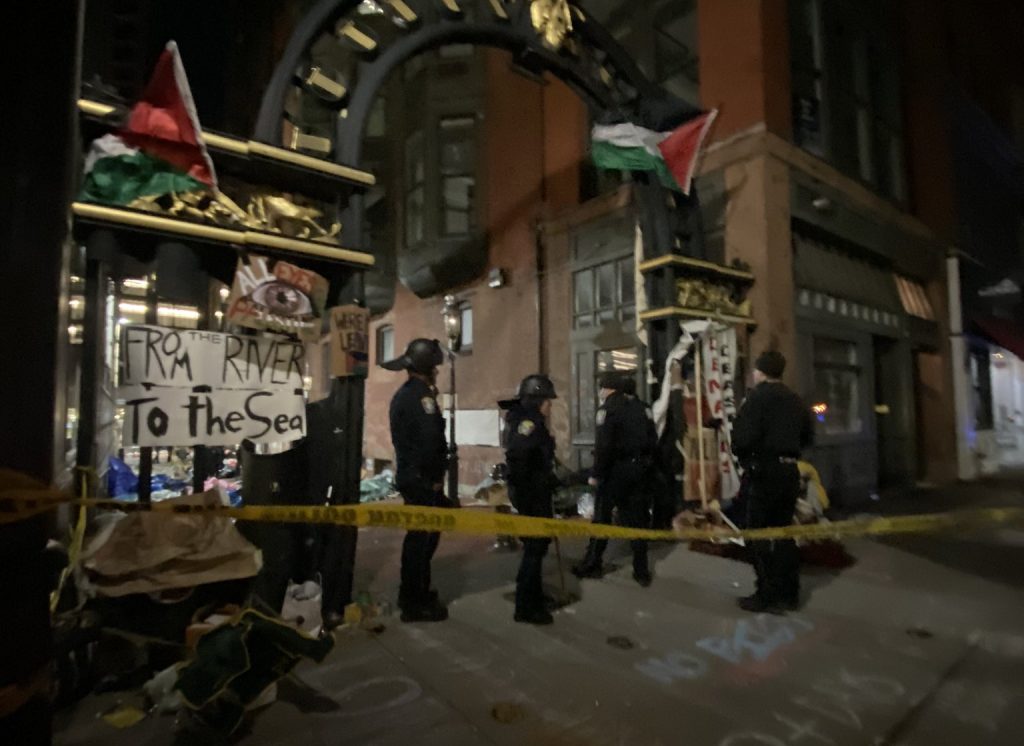[[{“value”:”
In a narrow alleyway, roughly 200 student protestors stood shoulder to shoulder as riot police streamed in. Their heroic stand should inspire us all.
By Henry De Groot
THEATER DISTRICT – It’s been a long time since anyone called this part of town the Combat Zone. That name recalls a grittier Boston of the 80s and 90s in which peep shows and late night brawls characterized the neighborhood, although these have long since been replaced by throngs of tourists and a Tatte Bakery and Cafe with a view of the Boston Common.
Now this neighborhood – which runs from Downtown Crossing to Tufts Medical Center and centers on the corner of Boylston and Tremont – goes by a nicer, realtor-approved name, which is in no small way related to the liberal arts college, Emerson, which dominates the neighborhood.
Despite the name change, on Thursday morning public workers set out with pressure washers to clean blood off the bricks of Boylston Place, a small pedestrian-only public alley tucked between Emerson buildings.
The blood presumably belonged to one of the more than 100 Emerson students who were arrested after Boston Police forcefully raided the encampment at 2 a.m. Thursday morning. It is hard to tell whose blood it is as no news cameras were rolling to film the police raid; presumably hiding from the cameras was part of the reason why progressive mayor Michelle Wu waited until the early hours of the morning before assembling around 200 riot cops to storm the alley. If not for a few livestreamers and a handful of amateur journalists including Dan Albright, Evan George, and myself, the city may not have woken up to the appalling videos of the mass-arrests.
The Making of A Police Raid
When I stopped by the Emerson encampment on Wednesday afternoon it was beginning to look more and more like a rag-tag military camp.
At the alley’s entry stood 20 students in three lines, standing arm and arm under a black iron gate covered in posters and banners and flying a Palestinian flag. Under the confident direction of a young female student draped in a keffiyeh, the lines of students drilled for the inevitable scrum with police, although they let in campus administrators and passersby. Scouts watched cautiously for cruisers or Zionist provocateurs.
In the alley itself, students attended to the various needs of the encampment, assembling donations of food and blankets at the supply tables, plating out meals, and painting banners of green, black, and red. Since I had visited the day before, students had strung up tarps over the tents in defense against the cold rains of late April, and two students struggled to secure them as a harsh wind whipped through the alleyway. Some students played cards, huddling under donated blankets.
It was not obvious to me that the camp would be stormed when I headed home at 10 in the evening. The Boston Globe had reported that police were warning of an impending action, but that might not come for several days. But just as soon as I arrived home, I got word that help was needed back at camp. Arriving by car, I saw a line of around a dozen vehicles from the Massachusetts State Police parked on Charles Street, as well as a few trucks from the Fire Department.
The back of Boylston Place leads to an entrance to the State Transportation Building. And that was where around a dozen state troopers in hi-viz jackets assembled, far too few to make an incursion into the protest, but too many to be there for any other reason. Walking on foot to the Charles Street side of the building, I waved through the window to a Statie parked on the street. Using some Boston intonations I learned while working at Dunkin Donuts asked him, “When you guys arrest the students, where are you going to take them?”
“It’s BPD’s show,” he replied, confirming my suspicions of an imminent action. “Probably to A1.”
I returned to warn the students. They could see the Staties through the windows of the State Transportation Building, and were growing increasingly agitated.
I doubled back to Charles Street to wait for police reinforcements. BPD cruisers began arriving and officers entered the building in ones and twos, carrying helmets and armor in large duffel bags.
Once again I returned to the encampment, where I joined up with Dan. The protestors had sealed off the front gate, so Dan and I ducked down a side alley which led us around in front of the back line of protestors. Out of nowhere, a dozen open umbrellas had appeared, held by the first line of students to protect them from projectiles. In front of them, they had raised a thin barricade of picnic tables and trash barrels. I slipped behind the line into the middle of the encampment.
“Have you ever been tear gassed? What’s it like?” asked a nervous sophomore.
“It’s pretty intense,” I replied, not wanting to lie. “It gets in your eyes and lungs all at once and can be pretty overwhelming.”
“Oh,” he responded quietly.
“You’ll be okay,” I said, trying to sound convincing.
From All Sides And All At Once
Suddenly there was a commotion at the front gate, and Dan and I rushed over. I climbed up the iron frame of the right side of the gate, poking my head and camera through so I could see what was happening on the street.
A line of police vans had pulled up and a large number of riot police were forming up. A police officer read out a city ordinance over the loudspeaker of a parked cruiser; I struggled to make out his words although I was only 15 feet away, as the loudspeaker was drowned out by chants. I later learned that it was the anti-homeless ordinance passed in 2023 which banned setting up tents in public ways.
“FREE FREE PALESTINE!”
Running and posting my footage to social media simultaneously, I rushed back to the rear line, hopping up on a picnic table for a better view. From behind, there was shouting and I could see that the front line was under siege and quickly folding. “Here they come!” I shouted.
Calm and authoritative, a student yelled, “Back line! Reinforce!” A dozen students hurried to reinforce the front gate in reasonable order despite the growing cacophony.
Turning back to the rear of the alley, I looked over the heads of the protestors as 50 or so riot police stormed out of the transportation building and headed towards us. The burly officers made quick work of the barricades in front of the student protestors, and in an instant they were upon the front line of students.
The next 90 seconds were a blur as police immediately began tugging on protestors, pulling them away from the arms of their comrades and tossing them on the floor, twisting their wrists into waiting zip-ties.
Students pressed back into the table I was standing on, which started to wobble violently. I hopped down, trying to post the footage I had just taken in case I was arrested. I had time to type three words, “Mass Arrests Begin,” and prayed that the video would upload correctly.
Not intending to be arrested, I leaped over bags of blankets as I tried to make for the side-alley, but a cop was already blocking it. The police were on me, and I shouted “press! press! I’m a journalist” as I wove my way through them. A cop grabbed me and pushed me out of the alley and past the police lines on the sidewalk out front. Later I learned that Dan, who was only 10 steps behind me, was not so lucky.
Out front, police were loading students into police vans. But the students would not go silently in the night, and the rhythmic thumping and chanting from protestors inside the vans filled the street loudly.
“WE KEEP US SAFE! WE KEEP US SAFE!”
It did not take long for the police to usher away more than 100 arrested students. Only a few onlookers, a recently arrived camera man from the local news, and myself remained, and still for hours the riot police cordoned off the street.
As dawn approached, the alley bore witness to the aftermath of the clash. The banners at the gate were torn, and broken zip ties and empty water bottles litter the ground. But still, over the gate, a Palestinian flag flew proudly.
The Battle of Boylston Place
The worn tombstones of the Central Burying Ground stand directly opposite from Boylston Place. Many of them mark the bodies of colonists and British soldiers alike who fought at the Battle of Bunker Hill.
At that battle, the colonists famously proved not that they could defeat the British in open combat, but that at least they could go toe-to-toe with the most powerful military on Earth. Although they inflicted heavy British casualties, they ultimately retreated; but the real victory was one of morale – the heroic stand of the soldiers at Bunker Hill, their heroic sacrifices, inspired thousands more to join their ranks.
Three days of drilling in formation did not create a force of students strong enough to repel the riot police, but it did create a force strong enough to stand toe-to-toe and resist en-masse.
And perhaps since the first day that Emerson students set up their tents, it was inevitable that they too would have their heroic stand. The alleyway was always a terribly indefensible position, but the close quarters had the benefit of steeling the students’ resolve. Three days of drilling in formation did not create a force of students strong enough to repel the riot police, but it did create a force strong enough to stand toe-to-toe and resist en-masse.
The protest at Emerson College may have been quelled by force, but its impact reverberates far beyond the confines of the alleyway. The stories of the students heroic stand and the videos of the terrible police raid are inspiring thousands of students around the country, recalling images of the protests against Vietnam, as little Emerson joins the proud ranks of Columbia, University of Texas, Yale, and other campuses which have squared off with police in defiance of genocide. Emerson serves as a rallying cry for justice, inspiring a new generation to stand firm in the face of oppression and tyranny.
All that was missing for the students to fulfill such a heroic and historic role was an order for the police to clear them out. Mayor Wu was happy to oblige.
Despite never having experienced the hardship of the people living under bombardment in Gaza, students took it into their own hands to demand that their institutions stop profiting from genocide.
Henry De Groot is the Managing Editor of Working Mass, a member of Boston DSA and the Reform and Revolution caucus. He was a member of SJP at UCLA, and is the author of the book “Student Radicals and the Rise of Russian Marxism.”
“}]]

